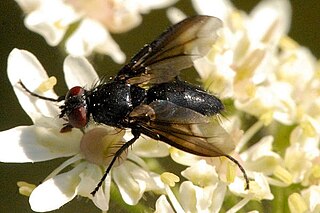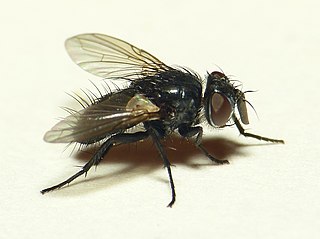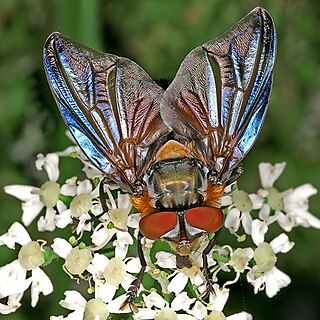
The Tachinidae are a large and variable family of true flies within the insect order Diptera, with more than 8,200 known species and many more to be discovered. Over 1,300 species have been described in North America alone. Insects in this family commonly are called tachinid flies or simply tachinids. As far as is known, they all are protelean parasitoids, or occasionally parasites, of arthropods, usually other insects. The family is known from many habitats in all zoogeographical regions and is especially diverse in South America.
Actinochaetopteryx is a genus of tachinid flies in the family Tachinidae. Its members occur in the Palaearctic, Oriental, and Australasian realms.
Pradocania is a genus of flies in the family Tachinidae.

Linnaemya is a genus of flies in the family Tachinidae.
Lixophaga is a genus of flies in the family Tachinidae.

Actia is a genus of large flies in the family Tachinidae.

Voriini is a tribe of flies in the family Tachinidae. More junior homonyms exist of Wagneria than any other animal genus name.

Dexiinae is a subfamily of flies in the family Tachinidae.

Dexiini is a tribe of flies in the family Tachinidae.

Exoristinae is a subfamily of flies in the family Tachinidae. Most species are parasitoids of caterpillars.

Blondeliini is a tribe of parasitic flies in the family Tachinidae. Larvae are parasitoids of other insects, mostly beetles and caterpillars. Although nearly cosmopolitan, its greatest diversity is in the New World and especially in South America.

Eryciini is a tribe of flies in the family Tachinidae.

Goniini is a tribe of parasitic flies in the family Tachinidae. Members of Goniini are distinguished from other Tachinidae by laying small "microtype" eggs that hatch only after being ingested by a host.
Erynniopsis is a genus of flies in the family Tachinidae.
Brachicheta stricata is a species of fly in the family Tachinidae.

Phasiinae is a subfamily of flies in the family Tachinidae. Except for the small tribe Strongygastrini members of this subfamily attack only Heteroptera.

Tachininae is a subfamily of flies in the family Tachinidae.

Minthoini is a tribe of flies in the family Tachinidae.
Siphona (Ceranthia) tristella is a species of tachinid flies in the subgenus Ceranthia of the family Tachinidae.

Tachinini is a tribe of flies in the family Tachinidae.











